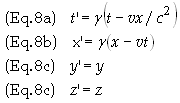
Lorentz
Transformation
Back
to Physics World
Back to Special Relativity
In
relativity the most important concept is that of an event. An event is something
that can be labeled with a time and a position. A firecracker detonating is an
example of an event. To specify the spatial location of an event three numbers,
i.e. spatial coordinates, are required. The numbers are chosen to
uniquely specify the location of an event. To specify the time of an event a
single number is required, a temporal coordinate. The location, r
= (x, y, z), and time, t, together constitute an event X
º
(ct, x, y, z). We desire a relationship between the coordinates of two
inertial frames of reference. Consider two such frames, S and S’
which are in standard configuration with S’ moving with a velocity v
with respect to S in the +x direction. See Fig. 1

E
is the event whose spatial coordinates we wish to find. The event can be
specified in two ways corresponding to two sets of spacetime coordinates. In
terms of the coordinates corresponding to frame S frame we have
![]()
In terms
of the coordinates corresponding to frame S’ frame we have
![]()
In the
primed coordinate system the distance from the y’z’ plane to the
event is x’. Let d represent the distance from the y’z’
plane to the event. Then since the relative velocity of S and S’
is v it follows that
![]()
However
due to Lorentz contraction d and x’
are not equal but are related by
![]()
Substituting
this into Eq. (3) and solving for x’ gives
![]()
This is our first relation for the set of transformation equations that we are looking for. Due to the principle of relativity there should be no difference between the two frames except for a change of sign for the velocity. Thus we simple exchange x’ with x, t’ with t, and v with –v to give
![]()
We now
are in the position to find t’. We
substitute x’ from Eq. (5)
and then solve for t’

This is
the second relation we need. Due to the fact that distances perpendicular to
motion does not contract then we know immediately that y’ = y and z’
= z. We therefore have our complete transformation from S to S’

The
transformation given by Eq. (8) is called the Lorentz transformation.
Back
to Special Relativity
Back to Physics World